Judy and Jim Cruise the Danube
Dürnstein and Melk
On Thursday morning, the ship was docked before breakfast, and we were the middle one of three tied up next to a small village. The weather wasn’t all that cooperative, damp and drizzly, but Judy and I were ready for our shore excursion anyway. Three choices were offered, but we didn’t hesitate before making our decision. We’ve visited a lot of vineyards and wineries, from Belgium to Texas, and we’re not the types to take a long bicycle tour along anyone’s river, no matter how scenic. There was always the option of just wandering around Dürnstein on our own, but we wanted a little more from the day.
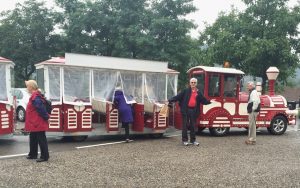 So we opted for the “Saffron Experience” and went to a small shop in what used to be the local train station. We rode a little “toy train” to get there and went in for a really nice talk about growing and using saffron. That’s right — saffron. That really expensive spice that turns foods yellow. There were a few other people from our ship that made this choice, and I suppose they were like us. Judy and I were both interested in learning something. The talk was interesting and informative, and we got to sample different dishes made two ways: with and without saffron. Turns out it can be used in more than just your favorite paella. Who knew? We made a few purchases at the little shop, then went into the heart of the little village to extend our morning visit a little.
So we opted for the “Saffron Experience” and went to a small shop in what used to be the local train station. We rode a little “toy train” to get there and went in for a really nice talk about growing and using saffron. That’s right — saffron. That really expensive spice that turns foods yellow. There were a few other people from our ship that made this choice, and I suppose they were like us. Judy and I were both interested in learning something. The talk was interesting and informative, and we got to sample different dishes made two ways: with and without saffron. Turns out it can be used in more than just your favorite paella. Who knew? We made a few purchases at the little shop, then went into the heart of the little village to extend our morning visit a little.
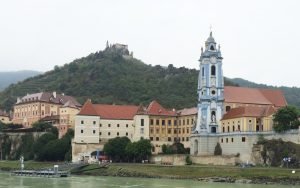 Dürnstein is a pretty little place. The location, right on the bank of the Danube, couldn’t be better, and the hills beyond the village with rows of vines and apricot trees just make it more beautiful. The local claim to fame can be seen at the top of the nearest and tallest hill: the ruins of a castle said to have been the site of Richard the Lionheart’s captivity during his ill-fated attempt at leading a Crusade. We passed on the opportunity to hike up to the ruins of the castle, not being at all sure we could make it even half-way up that gentle slope. We just took the little toy train from the “Saffron Experience” to the heart of the village. Judy shopped around for a bit while I struck out to find the local church. (Some habits are hard to kick.)
Dürnstein is a pretty little place. The location, right on the bank of the Danube, couldn’t be better, and the hills beyond the village with rows of vines and apricot trees just make it more beautiful. The local claim to fame can be seen at the top of the nearest and tallest hill: the ruins of a castle said to have been the site of Richard the Lionheart’s captivity during his ill-fated attempt at leading a Crusade. We passed on the opportunity to hike up to the ruins of the castle, not being at all sure we could make it even half-way up that gentle slope. We just took the little toy train from the “Saffron Experience” to the heart of the village. Judy shopped around for a bit while I struck out to find the local church. (Some habits are hard to kick.)
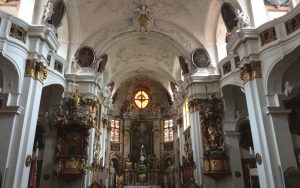 The restored blue tower of the church stands out in any view of the village itself, from the river or from any of the surrounding area. Turns out it’s a former Augustinian Abbey used as a parish church since 1788. I wandered along some streets looking for a way into the church and discovered I needed to pay for admission to the entire complex, entering the church through the courtyard.
The restored blue tower of the church stands out in any view of the village itself, from the river or from any of the surrounding area. Turns out it’s a former Augustinian Abbey used as a parish church since 1788. I wandered along some streets looking for a way into the church and discovered I needed to pay for admission to the entire complex, entering the church through the courtyard.
I’m really glad I did it. The church is a little gem of High Baroque architecture. It was absolutely packed with carved and gilded wood, had a gold-tinted window above the altar like St. Peter’s in Rome, and gave every appearance of being home to an active parish.
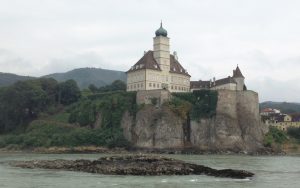 Lunchtime and early afternoon on the ship would have been much more enjoyable in clear weather. In fact the Wachau Valley of the Danube, about 25 miles long, including the area around Durnstein and continuing through to Melk, is one of UNESCO’s listed World Heritage Sites. Even in the drizzle, there are beautiful mountains, vineyards for miles, and castles on rocky promontories, either whole or in ruins. Some of those, especially the ruins, are even more interesting in the mist of a rainy day. Too bad good weather can’t be gaaranteed. Maybe the rainy weather and resultant hazy photographs are just further reasons to make a second trip.
Lunchtime and early afternoon on the ship would have been much more enjoyable in clear weather. In fact the Wachau Valley of the Danube, about 25 miles long, including the area around Durnstein and continuing through to Melk, is one of UNESCO’s listed World Heritage Sites. Even in the drizzle, there are beautiful mountains, vineyards for miles, and castles on rocky promontories, either whole or in ruins. Some of those, especially the ruins, are even more interesting in the mist of a rainy day. Too bad good weather can’t be gaaranteed. Maybe the rainy weather and resultant hazy photographs are just further reasons to make a second trip.
The overall highlight of the day, however, wasn’t dimmed a bit by the drizzle: our tour of Melk Abbey. The place itself is astonishing, its current use as a school is impressive, and it is within itself a marvelous example of the continuing presence of historically significant art and architecture in today’s world. In other words, it’s beautiful, no matter how you look at it.
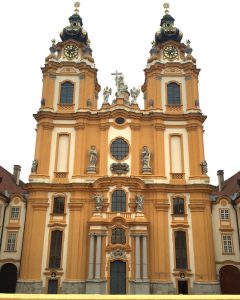 We took a bus from the Melk mooring point up to the grounds of the Abbey, where the River Beatrice passengers were split up into five groups for the Abbey tour. There were rooms designed for orientation to the history of the Abbey as well as some rooms that contained some of the Abbey’s treasures on exhibit. Then we went through several rooms that were art history museums in and of themselves. Beautiful inlaid floors and incredible ceiling murals, not to mention stunning views through the windows, were everywhere. We got a little bit of time on one of the ramparts, where the decision for most of us was whether to look out at the river and valley below or concentrate on the Chapel facade when we lookedthe other way. I had looked forward to seeing the Library, and I wasn’t disappointed. Judy and I both thought it reminiscent of Trinity College Library, Dublin, just on a smaller scale, but that might say more about our limited experience than anything else. When we left the Library, we headed through a couple of additional rooms, around a corner or two, and down some steps to enter the Chapel.
We took a bus from the Melk mooring point up to the grounds of the Abbey, where the River Beatrice passengers were split up into five groups for the Abbey tour. There were rooms designed for orientation to the history of the Abbey as well as some rooms that contained some of the Abbey’s treasures on exhibit. Then we went through several rooms that were art history museums in and of themselves. Beautiful inlaid floors and incredible ceiling murals, not to mention stunning views through the windows, were everywhere. We got a little bit of time on one of the ramparts, where the decision for most of us was whether to look out at the river and valley below or concentrate on the Chapel facade when we lookedthe other way. I had looked forward to seeing the Library, and I wasn’t disappointed. Judy and I both thought it reminiscent of Trinity College Library, Dublin, just on a smaller scale, but that might say more about our limited experience than anything else. When we left the Library, we headed through a couple of additional rooms, around a corner or two, and down some steps to enter the Chapel.
I’m not going to say anything here about the Chapel interior. Words aren’t needed. You’ll have to check out the photo pages to see that, and you’ll be glad you did.
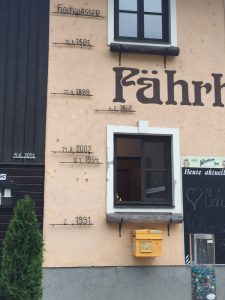 We left the Abbey and returned to the ship by bus, stopping at the tavern down near the Danube. Note that it was a good fifteen or twenty feet above the water level. The entrance to the interior of the place was up a few steps, and it looked like it was built that way to avoid the occasional flood. Then the guide pointed out the marks on the side of the building, showing how high those floods had actually reached in some years. No need to say anything about that either, because Judy’s photo speaks for itself.
We left the Abbey and returned to the ship by bus, stopping at the tavern down near the Danube. Note that it was a good fifteen or twenty feet above the water level. The entrance to the interior of the place was up a few steps, and it looked like it was built that way to avoid the occasional flood. Then the guide pointed out the marks on the side of the building, showing how high those floods had actually reached in some years. No need to say anything about that either, because Judy’s photo speaks for itself.
By the ime we got back on board and changed, it was time for the evening talk and dinner. We learned that the white wine of the evening was a Gruner Veltliner from the vineyard and vintner some of the passengers had visited that morning. I’m sure they enjoyed the visit, and I know without a doubt that I enjoyed the wine.
After dinner it was off to bed to dream about the next day’s trip to Salzburg.
